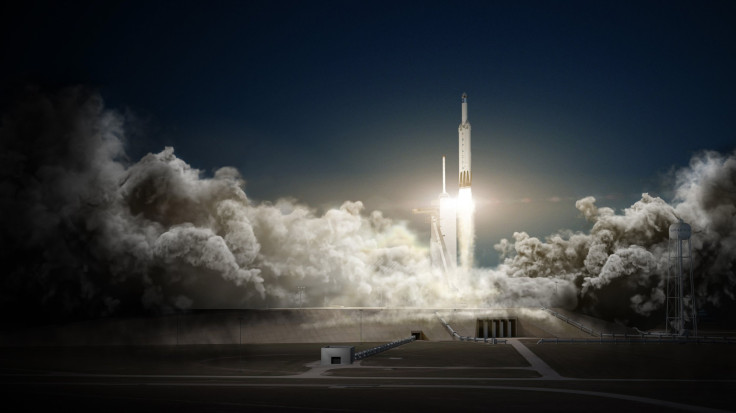WATCH: SpaceX Falcon Heavy Launch Animation Shared By Elon Musk

Ten days after announcing that the Falcon Heavy rocket will make its maiden flight in November, SpaceX CEO Elon Musk again took to his Twitter and Instagram accounts Sunday to share the “first draft animation” of what the debut of the rocket — currently the world’s most powerful — could look like.
First draft animation of the Falcon Heavy three core launch. FH is twice the thrust of the next… https://t.co/vgZxF6LRMR
— Elon Musk (@elonmusk) August 6, 2017
Keeping in line with what SpaceX has been doing with the Falcon 9 rockets, the animation shows both the side boosters (each of them a Falcon 9) of the rocket landing back on Earth after sending the core on its way. After the first and second stages separate, the first stage rocket (also a Falcon 9) aligns itself for reentry and while the animation shows it landing on ground, Musk had earlier said the center booster will actually land on a drone-ship.
Side booster rockets return to Cape Canaveral. Center lands on droneship.
— Elon Musk (@elonmusk) July 28, 2017
Read: Elon Musk Announces November Test For Falcon Heavy
Musk warned once again that the November debut of the Falcon Heavy (an exact date hasn’t yet been fixed) could be a failure when he said in the Instagram post there was a “lot that can go wrong in the November launch…”
Earlier, when he announced the first flight of the rocket and was replying to some of his many Twitter followers, Musk had mentioned luck as a factor.
If we're lucky
— Elon Musk (@elonmusk) July 28, 2017
While speaking at the International Space Station Research and Development Conference in Washington, D.C., on July 19, Musk said even just getting away with no damage to the launch pad would be considered something of a success.
“There’s a lot of risk associated with Falcon Heavy, a real good chance that that vehicle does not make it to orbit. I want to make sure to set expectations accordingly. I hope it makes it far enough beyond the pad so that it does not cause pad damage. I would consider even that a win, to be honest,” Musk reportedly said of the November test.
Despite the repeated success of Falcon 9 (barring the one on-ground explosion in September 2016), Musk has repeatedly stressed that putting the Falcon Heavy in orbit will not be easy. That three of the familiar rocket’s cores were being put together to power the Falcon Heavy didn’t make things simpler, Musk explained told the International Space Station Research and Development Conference.
“At first it sounds real easy, you just stick two first stages on as strap-on boosters, but then everything changes. All the loads change, aerodynamics totally change. You’ve tripled the vibration and acoustics. You sort of break the qualification levels on so much of the hardware. … The amount of load you’re putting through that center core is crazy because you’ve got two super-powerful boosters also shoving that center core, so we had to redesign the whole center core airframe. It’s not like the Falcon 9 because it’s got to take so much load. Then you’ve got separation systems,” Musk said.
Read: Is Jeff Bezos Working On A Rocket Bigger Than Falcon Heavy?
There are two Falcon Heavy tests scheduled for the first half of 2018, and their fate will depend on how the November test goes. All tests will take place from NASA’s Kennedy Space Center in Cape Canaveral, Florida. SpaceX can’t use its own Texas testing facility because it can’t support the thrust (5.1 million pounds at take-off) generated by the Falcon Heavy.
If there are no unexpected explosions and damaged launch pads, commercial flights of Falcon Heavy will start in the latter half of 2018. The pricing details on the SpaceX website say customers would have to pay $90 million to send up to 8 metric tons of payload to geosynchronous transfer orbit. The largest rocket in operation currently — the United Launch Alliance’s (a Boeing-Lockheed Martin joint venture) Delta Heavy IV — has almost half the payload capacity of the Falcon Heavy. So putting the rocket into commercial operation could mean a big business boost for SpaceX, which — with an estimated valuation of $21 billion — is already among the world’s most valuable privately held companies.
© Copyright IBTimes 2024. All rights reserved.





















